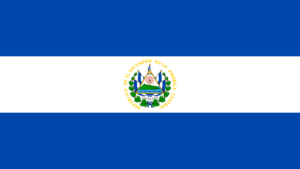The indigenous people of El Salvador were the Pocomame, Lencas, and Pipyrus Indian tribes. The Spaniards were the first Europeans to visit the El Salvador area. The first to arrive in 1522 was the Spanish Admiral Andrés Niño. A few years later came the conqueror Pedro de Alvarado and his brother Gonzalo. They conquered the area and soon the village of San Salvador was born. The area was under Spanish rule for many years until 1811, when a priest named José Matias helped lead Delgado’s rebellion against Spain. Along with other states in Central America, El Salvador declared her independence in 1821.
Much of El Salvador’s history since then has been marked by civil war and turmoil. A civil war in the 1980s tore the country apart and left many dead. In 1992, peace was signed with the rebels and a degree of democracy was established.
| Capital | San Salvador |
| Population | 6,369,226 (Source: 2023 worldometer) |
| Major Cities | SAN SALVADOR (capital), Santa Ana, San Miguel |
| Borders | Honduras to the north and east, by the Pacific Ocean to the south, and by Guatemala to the northwest |
| Gross Domestic Product (GDP) | $32,488,720,000 (2022 worldometer) |

El Salvador Major Industries: food processing, beverages, petroleum, chemicals, fertilizer, textiles, furniture, light metals
El Salvador Agricultural Products: coffee, sugar, corn, rice, beans, oilseed, cotton, sorghum; beef, dairy products; shrimp
El Salvador Natural Resources: hydropower, geothermal power, petroleum, arable land
El Salvador Major Exports: offshore assembly exports, coffee, sugar, shrimp, textiles, chemicals, electricity
El Salvador Major Imports: raw materials, consumer goods, capital goods, fuels, foodstuffs, petroleum, electricity
Total Size of El Salvador: 21,040 km² (source: 2022 The world factbook)
Geographical Low Point of El Salvador: Pacific Ocean 0 m
Geographical High Point of El Salvador: Cerro El Pital 2,730 m
Climate of El Salvador: Tropical; rainy season (May to October); dry season (November to April); tropical on coast; temperate in uplands
General Terrain of El Salvador: Mostly mountains with narrow coastal belt and central plateau
World Region or Continent of El Salvador: Central America
El Salvador Geographical Coordinates: 13 50 N, 88 55 W
El Salvador Government Type: Republic
El Salvador Nationality: Salvadoran (s)
El Salvador National Holiday: Independence Day, 15 September (1821)
El Salvador Independence: 15 September 1821 (from Spain)
El Salvador National Symbol: Turquoise-browed motmot (bird)
El Salvador National Anthem or Song: Himno Nacional de El Salvador (National Anthem of El Salvador)
El Salvador Languages Spoken: Spanish, Nahua (among some Amerindians)
El Salvador Religions: Roman Catholic 83%, other 17%
El Salvador is the smallest country in Central America, but one of the region’s largest commercial hubs, with the largest shopping malls in all of California.
The currency of El Salvador is the US dollar, which has been in use for over ten years. This makes it much easier for travelers to make payments without currency calculations.
Salvadorans are also called Guanacos. Sometimes it is received negatively, but sometimes it seems that they wear it with pride.
El Salvador is one of the world’s most popular surfing destinations, hosting countless surfing competitions each year.
Of all Central American countries, it is the only country without a Caribbean coast.
El Salvador is known for having some of the most active volcanoes in Central America.
Pupusas are the most traditional food of El Salvador and a de facto national symbol. It’s basically a corn tortilla stuffed with cheese or whatever else you can think of, but the most traditional ones contain beans. With an area of 21,000 km² and a population of over 7 million, it is also the most densely populated country in Central America.
El Salvador’s climate is tropical. So be prepared for heat and humidity. Bring fresh clothes and remember to stay hydrated.
Like most other Central American countries, they pride themselves on producing quality coffee for export. So be sure to try something else.
For nature hikers, a visit to Cerro El Pital (the highest point in the country) or Santa Ana volcano is the best option. Lake Coatepeque is also a must-see for travelers.
The country has a UNESCO World Heritage Site called Joya de Seren. It was a pre-Hispanic farming community. It was buried under volcanic ash when the Laguna Caldera erupted. This place is now a ruin.
The country is also famous for surfers. Due to the strong waves and tides, it is not suitable for swimming, but it is also an interesting place for surfers.
The country is also available as an inexpensive travel destination. Budget travelers can live like royalty for $40-50 a day.

